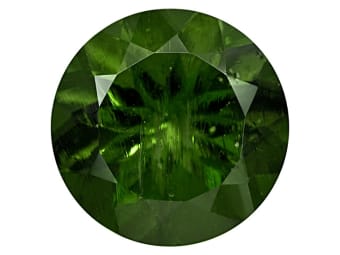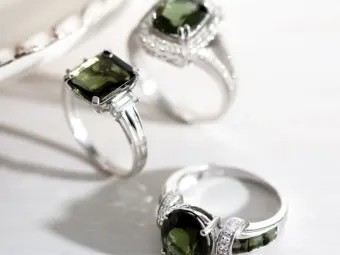Moldavite is an interesting gemstone with a unique story dating back to 1908. Shards of moldavite were found in the town of Willendorf, Austria with a figurine of a woman later named the Venus of Willendorf. The limestone statue is from the Paleolithic period, which makes it over 27,000 years old. Although humanity has come a long way, the love and fascination with moldavite has not decreased, especially since a paleolithic society felt that moldavite was significant enough to leave pieces of it with a figurine to represent fertility and beauty.
Today, moldavite can be carved, faceted, set in jewelry or left in its natural state. While all pieces of moldavite are unique in their own way, the formation of this special gem sets it apart from other earthly gemstones.
What is moldavite?
Moldavite is a type of tektite, which is gemstone material created by meteorite impacts on earth. The force of these meteorite impacts instantly melt surrounding soil and rock, creating molten glass. This molten glass is then flung into the air where it cools as it falls to the ground.

What are tektites?
Tektites are classified by their fairly similar form, which is predominantly made of silica glass called lechatelierite. Lechatelierite earns its name from a lack of several items, including water or other volatiles, microscopic crystals, and a lack of chemical relation to the local sediments where they are found.
Where is moldavite found?
Tektites occur in what are known as strewn fields. Strewn fields are the resting places for material ejected from meteorite craters. Moldavite is currently found anywhere from over 150 to 280 miles away from the Nördlinger Ries impact crater in Germany. This is a large impact crater that is almost 15 miles across with a depression visible on aerial photos.

Where are strewn fields?
From the Nördlinger Ries impact crater, there are four main strewn fields: southern Bohemia and southern Moravia (both in the Czech Republic), Waldviertel (Austria), and Lausitz (eastern Germany). The most famous moldavite deposits are in southern Bohemia near České Budějovice where moldavite is found in sand pits near Ločenice and Vrábče. It is also found in a clay pit near Besednice.
What are the colors of moldavite?
Moldavite is not only unique in its origin from other gemstones, but it also differs in color, shape and size among other specimens. When it comes to color, moldavite can range from brown to olive green to brighter bottle green. Moldavite’s colors can also be loosely related to different strewn fields. For instance, gemstones from the Czech Republic that are more bottle green and transparent are typically from the southern Bohemian sites. Olive green to brown moldavite is typically from southern Moravia, near Brno. Southern Moravian moldavite is not only more brown in color on average, but it's normally much larger in size than Bohemian moldavite.

What are the shapes and sizes of moldavite?
Moldavite can come in many shapes but is not typically large. The largest piece ever found weighs 238 grams or about a half pound. Compared to other well-known gemstones, this is tiny. One of the largest topaz gemstones, called the Adiël Topaz, weighs over 20,000 carats which is almost 9 pounds. While moldavite sizes may not be as impressive as some gemstones, moldavite can take on a few interesting shapes from how they form.

What are splash forms?
Moldavite shapes, called splash forms, make this uncut gemstone
highly collectible. Moldavite splash forms can be shaped like disks,
drops, ellipsoids, spheres or dumbbells. Other moldavite may be
partially formed shapes like a bar that was once part of a drop. These
splash forms are determined by centrifugal force and surface tension,
as well as atmospheric pressures flattening or stretching the glass
before it cooled.
Depending on how far a moldavite
traveled also affects the surface structure of the moldavite. Those
that did not travel as far will have very little surface changes,
while those that traveled farther will show some separation or
cracking of the surface. For some tektites, they traveled so far that
the effects of the atmosphere were similar to what meteorites experience.

Thankfully, moldavites are somewhat near their impact site as beautiful specimens rather than burned pieces from reentry. Some of the most sought-after moldavites are also extremely weathered resulting in surface etching. Those from Besednice are especially etched and are affectionately called hedgehogs because they appear prickly.
How long will moldavite last?
Moldavite is an interesting stone with an incredible journey, but it may not be readily available for future generations. Since it was created from a meteorite impact millions of years ago, those conditions are impossible to recreate. Not only that, but because it’s from a strewn field located in a specific area and strata, once the stones have been mined out, there is no possible way to find it somewhere else in the world.

Where is moldavite mined?
Today, there is only one operating mine in the Czech Republic that produces moldavite in commercial quantity. With the current levels of production, it is estimated that moldavite will be completely mined out in the next ten years.
Another deposit located in Brusná has been mined out and is being prepared for cultivation. Mines in Ločenice and Nesměň are not currently in operation but could resume in the future. The production and supply of moldavite appears unsettled at this time.
What is moldavite's healing and spiritual properties?
Moldavite is not only geologically a fascinating stone, but there are many metaphysical properties about it. Since moldavite carries both terrestrial and stellar energies, it is typically seen as a very high-energy stone and believed to be a source of connectivity. Those that believe in moldavite’s spiritual properties use it to accelerate their personal and spiritual growth. It is even seen as a token of good fortune that can grant wishes and protection from dark energies for those who wear it.
Regardless of having spiritual energy or not, moldavite has amazing geological qualities, and will never cease to fascinate humankind in one form or another

